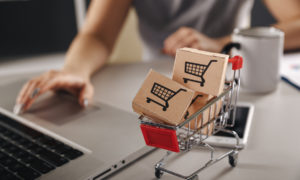Buy online, pick up in store (BOPIS) and inventory management go hand-in-hand. An accurate inventory is the key to a seamless, omnichannel shopping experience. And without it, BOPIS can’t succeed. In fact, 66% of retailers cite inventory inaccuracies as a cause for inconsistent BOPIS order fulfillment.
For retailers hoping to improve their inventory management, offering in-store pickup doesn’t have to be a burden — BOPIS can be part of the solution. Here are a few of the ways BOPIS brings supply tracking up to speed to boost sales and keep shoppers satisfied.
Opening a gateway to omnichannel fulfillment
Online orders may increase sales, but shipping them from the distribution center to the customer is costly. With BOPIS orders, however, stores are processing, packing, and delivering items all in one place. So the more orders retailers can fulfill from stores, the greater their inventory turnover and logistical savings.
Shifting to omnichannel operations in a way that achieves this level of profitability can be a complex endeavor. But it doesn’t have to be. Think of BOPIS as a bridge that connects the online and offline shopping experience. If a store’s online channel already has a reliable inventory management system, BOPIS can be a powerful catalyst for creating an automated inventory system in physical stores.
In a brick-and-mortar setting, an effective inventory system — and impeccably organized, efficient stockroom — relies on the same kind of technology retailers already use in warehouses. These tools include things like cloud-based barcode and radio frequency identification (RFID) scanning, which serializes inventory to track the location and movement of incoming, outgoing, and expired products. This particular technology can integrate with order management and checkout systems to create real-time stock visibility.
And to better predict demands and purchasing trends, retailers can adopt AI-powered analytics tools. This helps them determine how to stock appropriately across all platforms and avoid out-of-stock, overstock, and missed sales opportunities.
Personalizing purchases and shifting supplies
Retailers have a good idea of what items will be flying off the shelves during certain seasons, holidays, or special events — whether it’s hats and gloves as winter approaches, candy and pastel colors for Easter, or graphic novels for National Comic Book Day. Some retailers may also be using technology to personalize the online shopping experience based on these sales cycles. Bridging these offline and online customer habits using BOPIS helps merchants make the best use of available inventory.
Since 37% of BOPIS customers choose the service because they want items faster and 85% of them purchase additional items during the pickup process, BOPIS can help determine which items are the most popular during quick visits. Merchants can then increase the supply of those quick-moving items and push them toward the front of the store or next to the pickup location where they’re easily accessible.
BOPIS also provides a new avenue for analyzing customer behaviors in order to tailor promotions to their preferences and balance inventory across stores. Here are a few examples:
- If a customer regularly buys a particular item online but their local store has a surplus of that item, retailers can offer a coupon for a BOPIS purchase to encourage them to visit the brick-and-mortar store.
- Stores can target routine BOPIS customers with advertisements for products that are typically in high supply at their preferred stores.
- A store with low inventory can direct BOPIS customers to another nearby store with higher inventory. This way, the original store can reserve the limited stock for in-store shoppers.
- Retailers can see which stores are selling out of items fastest and getting the most BOPIS traffic, which can inform the redistribution of inventory between stores.
Preventing inventory loss
Shipping is not only expensive, it’s risky. Damage, theft, and misplaced packages often result in lost inventory that retailers replace or refund to maintain customer loyalty.
BOPIS keeps more of that inventory in the store, where products are safe until customer pickup. This simplifies and secures last-mile delivery so orders aren’t traveling around on delivery trucks or sitting on doorsteps and porches. And it’s not just retailers who benefit — nearly 25% of consumers use BOPIS because of security concerns. (Learn more about why customers choose BOPIS.)
For an added layer of inventory security, employees can place online purchases into package lockers, where customers can retrieve their orders in seconds without staff assistance. This way, orders aren’t stacked behind the counter or on a shelf near the store entrance, where they could get lost in the shuffle or swiped by other customers. And temperature-controlled lockers can keep sensitive items like groceries from spoiling.
Smart package lockers also integrate with inventory management and order fulfillment systems so store managers know, in real-time, which items are awaiting pickup, which have already left the building, and more. To find out about how smart lockers can streamline BOPIS services and aid supply tracking, check out Smiota’s smart package lockers.




